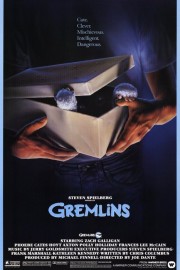Gremlins
There are so many questions one can raise regarding the intelligence scale of the gremlins in Joe Dante’s deliriously wicked horror comedy. I’m not at all convinced they can know how to thread and play a reel of “Snow White and the Seven Dwarfs,” for example, but we aren’t supposed to ask such logical questions, and just enjoy the Hell out of the madness Dante and screenwriter Chris Columbus have come up with.
I’m fairly certain my mom took me to watch this film in theatres; I would have been just shy of 7 years old, and it was probably the first, real horror film I experience. I’m surprised it didn’t traumatize me, especially when it comes to Phoebe Cates’s haunting story about her father on Christmas, but it takes adult eyes to recognize the genius in what Dante does here, which kept it (likely with executive producer Steven Spielberg’s guidance) from dipping into R-rated territory, as opposed to the PG rating it received. (This was pre-PG-13, and one of the films that sparked the conversation as to its creation, at the time.) In different hands, this is a visceral, “Evil Dead 2”-like dark comedy; what Dante does here that allows it to succeed is by emphasizing the comedy when the gremlins take over Kingston Falls, as opposed the violence that caused it to happen. That’s a benefit to the script by Chris Columbus, and how he wrote this premise, as much as it is on Dante’s execution.
The story is actually an inspired piece of formula- a father (Hoyt Axton) stops in to a shop in Chinatown, looking for a gift for his son, Billy (Zach Galligan). He finds an odd one in a Mogwai, a furry critter that seems pleasant, but comes with three rules to keeping him: keep him out of the light (especially sunlight, which will kill him); never get him wet; and don’t feed him after midnight. Naturally, all of these things happen, and the way Dante and Columbus build off of each one, and into each one, is part of the storytelling genius of this film, all the while introducing characters like Corey Feldman’s Pete; Phoebe Cates’s Kate; Billy’s parents (Axton and Frances Lee McCain); the evil Mrs. Deagle (Polly Holliday); Billy’s next-door-neighbor, Mr. Futterman (Dick Miller), and plenty more whom will find themselves dealing with the gremlins when chaos reigns supreme.
This is one of those films that probably shaped me more than I should admit. It’s blend of dark humor and safe scares is something that was easy to digest, and the characters are easily relatable, as we get a textured, albeit familiar sense of small-town America, and story that brings to mind tropes of holiday classics, especially “It’s a Wonderful Life.” The best material happens after the gremlins begin to run amok, but there are plenty of enjoyable elements and scenes like the beginning with the father and the store in Chinatown; his always-faultering inventions; the introduction of Gizmo; and the ways that it starts to turn into a nightmare during Christmas. The second the gremlins are set loose on Kingston Falls, however, Dante is unleashed, and the sheer creativity of how they deploy the gremlins, expertly performed by the puppeteers involved, is as entertaining and absurd now as it’s always been. I love the scenes and gags at the bar where Kate is still, inexplicably, serving them. I love the ways they cause Mrs. Deagle’s demise. I love how Billy’s mom dispatches some of them in her kitchen. And the scene where Spike breaks into the YMCA is one of the scariest scenes in any film from that decade in how he shoots it and how Jerry Goldsmith scores the festivities. His themes for Gizmo and the gremlins are as iconic as any created for a big blockbuster, and they are the final piece of the puzzle in how Joe Dante, Chris Columbus and Steven Spielberg made a genuine classic that crosses genre and remains entertaining for young and old alike.










